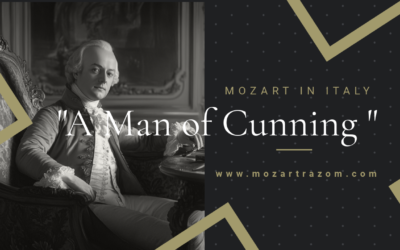Unveiling the Myth
Mozart's Thematic Catalogue Exposed as a Forgery
A groundbreaking forensic analysis reveals that Mozart’s thematic catalogue, long thought to be his own work, is a posthumous forgery. This discovery, detailed in Mozart: The Construction of a Genius, turns centuries of Mozart scholarship on its head, demanding a re-examination of his legacy.
Mozart: The Construction of a Genius
This book offers a fresh and critical look at the life of Wolfgang Amadeus Mozart, challenging the myths that have surrounded him for centuries. We strip away the romanticised image of the “natural genius” and delve into the contradictions within Mozart’s extensive biographies. Backed by nearly 2,000 meticulously sourced citations, this work invites readers to explore a deeper, more complex understanding of Mozart. Perfect for those who wish to question the traditional narrative, this biography is a must-read for serious music lovers and historians.
"The esteemed Mozart’s Thematic Catalogue, spanning 1784 to 1791, is an intricate forgery from the late 18th century."
Mozart: The Construction of a Genius
At the prestigious IGS 2023 Conference in Évora, Portugal, we revealed a bombshell that shakes the foundations of Mozart’s legacy. Our research uncovered that the famous thematic catalogue, long attributed to the composer, is a forgery. Using cutting-edge technology and painstaking forensic handwriting analysis, we have shown that the document was most likely fabricated after Mozart’s death, shattering long-held beliefs about the authenticity of his works.
Mozart’s wife, Constanze, has long been credited with preserving and authenticating this catalogue, yet the document never appeared during Mozart’s life. Only after his death did it emerge, forming the basis for the sales of his unattributed works. This raises significant doubts about Constanze’s role and the narrative surrounding Mozart’s catalogue. As we examine in detail in Mozart: The Construction of a Genius, this catalogue played a crucial part in elevating Mozart’s posthumous reputation, though it is now clear that its authenticity cannot be trusted.
Our bespoke C# software analysed hundreds of characters, comparing the writing in the catalogue with authentic manuscripts and letters from Mozart’s hand. The results were astounding—discrepancies in handwriting, clef shapes, and even the ink used, which was inconsistent with Mozart’s manuscripts. Particularly telling were examples like the word “Bassi,” whose form in the catalogue contrasts starkly with known examples from Mozart’s compositions. The watermarks also provided another clue, revealing connections to documents dated after Mozart’s death in 1791.
This forgery goes beyond simple discrepancies; it alters how we view Mozart’s works catalogued between 1784 and 1791, questioning the legitimacy of many pieces previously believed to be authentic. As explored in our book Mozart: The Construction of a Genius, this discovery raises deeper questions about the image of Mozart that has been manipulated over the centuries for various purposes—ranging from Constanze’s financial gain to nationalistic symbolism and commercialisation of the composer’s legacy.
The scholarly paper A Questionable Catalogue, presented at IGS 2023, corroborates these findings with compelling forensic evidence, adding weight to the notion that the thematic catalogue is not what it appears to be.
This discovery changes everything, forcing scholars to revisit the foundation of Mozart’s legacy. What other elements of the Mozart myth are based on unreliable sources? Our research opens the door to rethinking not just this document but the entire narrative around one of history’s most revered composers.
You May Also Like
#1 A Man of Cunning
In the end, Leopold Mozart’s life was a testament to survival in a world where his talents were often overshadowed by those of his more gifted contemporaries and his own son. While his “Violinschule” remains a notable contribution to music pedagogy, it is clear that Leopold’s legacy is as much about his ability to navigate the challenges of his time as it is about his musical achievements. His story is one of ambition, adaptation, and the lengths to which one man would go to secure his place in history, even if that place was built on borrowed foundations.
@MozartrazoM
Mozart’s Letters: A Legacy of Disappearances, Edits, and Forgeries
Mozart’s letters reveal missing originals, questionable authorship, and forgeries, adding complexity to his legacy.
The Curious Case of Mozart’s “Lullaby”
Though long credited to Mozart, the lullaby “Schlafe mein Prinzchen, schlaf ein” hides a murky history. Initially published by Nissen, Constanze’s second husband, it has endured as one of Mozart’s supposed works—despite a trail of doubts. In 1798, Constanze herself noted sending “another piece of Mozart’s in place of the lullaby,” raising questions about its origins. By the 20th century, researchers revealed it as the work of lesser-known composers, yet it remains deceptively tied to Mozart, its myth surviving through mere footnotes.
Mozart’s Bassoon Concerto: A Question of Authorship
The Bassoon Concerto K.191 raises more questions than it answers. Long thought to have been composed for a Munich bassoonist, new evidence suggests Mozart had no clear performer in mind. The concerto’s disjointed movements and other dubious compositions attributed to Mozart add further complexity to his legacy
The Contradictions Behind Mozart’s Horn Concerto K.412
The authenticity of Mozart’s Horn Concerto K.412 remains hotly debated, as the work bears numerous contradictions in its manuscript history. The first movement may be original, but what about the rest? The inclusion of Franz Xaver Süssmayr and later editorial meddling raises serious questions about what we are really listening to when we hear this ‘Mozart’ concerto.
The Forgotten Viennese Quartets
Attributing Offertorium K.34 to Mozart is not just misleading, it reflects the careless methods used by 19th-century scholars to inflate his legacy. Without an autograph or solid evidence, this work should not be considered part of his output.”







